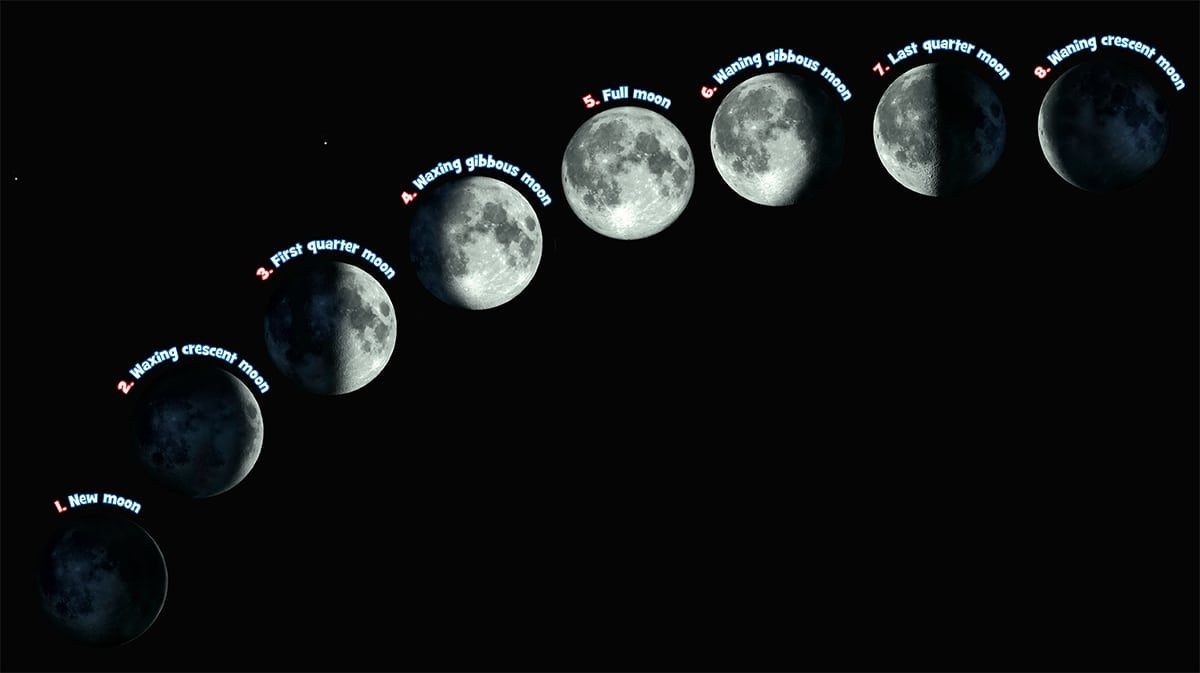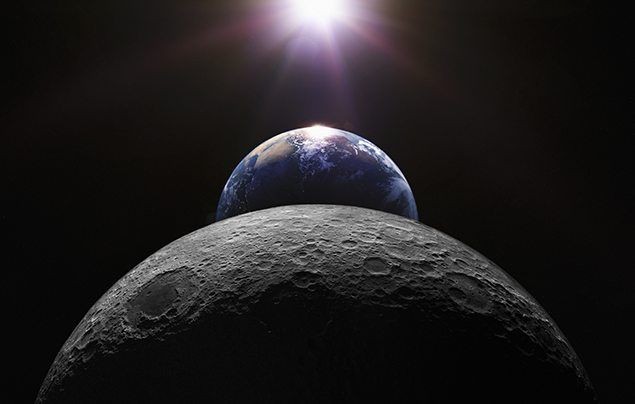Why Does The Moon Change Shape has been a captivating question for centuries, sparking curiosity across cultures and generations. WHY.EDU.VN offers an insightful exploration into the lunar phases, providing a clear and accessible explanation of this celestial phenomenon. Discover how the interplay of sunlight, Earth, and the moon creates the illusion of a changing lunar form, enhancing your understanding of our solar system and offering valuable astronomical insights.
1. Unveiling the Mystery: Why Does The Moon Seem to Change Shape?
The moon’s captivating dance across the night sky has intrigued humanity for millennia. The apparent transformation of the moon – from a slender crescent to a radiant full orb – is not due to a physical alteration. Instead, it’s a beautiful interplay of light and shadow. As the moon orbits Earth, the amount of sunlight reflected toward us changes, creating the illusion of different phases. Understanding this phenomenon unlocks a deeper appreciation for celestial mechanics and our place in the cosmos.
1.1 The Moon’s Illusion: Understanding Lunar Phases
The lunar phases are the different ways the Moon appears from Earth over about 29.5 days. The moon doesn’t emit light; it reflects sunlight. As the moon orbits Earth, we see different amounts of the sunlit surface, which creates the phases. These phases have been observed and documented by cultures worldwide, influencing calendars, agriculture, and mythology.
1.2 The Science Behind The Phases: How Light and Shadow Play
The phases of the moon are a result of the changing angles at which we view the moon’s illuminated surface. Here’s how it works:
- New Moon: The moon is between the Earth and the Sun. The side facing us isn’t lit, so we don’t see it.
- Waxing Crescent: A sliver of the moon becomes visible as it moves along its orbit. “Waxing” means it’s getting bigger.
- First Quarter: Half of the moon appears lit. This is when the moon is 90 degrees away from the sun in its orbit.
- Waxing Gibbous: More than half of the moon is lit, and it continues to grow larger each night.
- Full Moon: The entire face of the moon is illuminated because Earth is between the Sun and the Moon.
- Waning Gibbous: After the full moon, the lit portion starts to decrease. “Waning” means it’s getting smaller.
- Third Quarter: Again, half of the moon is lit, but on the opposite side compared to the first quarter.
- Waning Crescent: The illuminated sliver continues to shrink until it disappears entirely, returning to the new moon phase.
Understanding this cycle provides insight into the consistent and predictable nature of celestial movements.
2. Decoding the Lunar Cycle: The Eight Phases Explained
The lunar cycle is a continuous loop, but it is traditionally divided into eight distinct phases, each with its unique appearance and significance.
2.1 New Moon: The Invisible Start
The new moon marks the beginning of the lunar cycle. At this stage, the moon is positioned between the Earth and the sun. The side of the moon facing Earth is not illuminated, rendering it virtually invisible to the naked eye. This phase is often associated with new beginnings and introspection.
2.2 Waxing Crescent: A Glimmer of Light
As the moon begins its journey around Earth, a sliver of light appears, forming the waxing crescent. The term “waxing” signifies growth, and the crescent gradually widens each night. This phase symbolizes hope, potential, and the gradual manifestation of intentions.
2.3 First Quarter: Halfway There
Approximately one week into the lunar cycle, the moon reaches its first quarter phase. Half of the moon’s face is illuminated, appearing as a perfect semicircle. This phase represents a critical decision point, a time to evaluate progress and make necessary adjustments.
2.4 Waxing Gibbous: Approaching Fullness
Following the first quarter, the illuminated portion of the moon continues to expand, becoming a waxing gibbous. The term “gibbous” describes a shape that is more than half but less than full. This phase signifies abundance, growth, and the culmination of efforts.
2.5 Full Moon: Illumination and Clarity
The full moon is the most recognizable and celebrated phase of the lunar cycle. The entire face of the moon is illuminated, radiating a brilliant glow across the night sky. This phase symbolizes completion, clarity, and emotional intensity. It’s often a time for celebration, release, and heightened awareness.
2.6 Waning Gibbous: A Time for Reflection
After the full moon, the illuminated portion begins to decrease, entering the waning gibbous phase. “Waning” signifies decline or decrease. This phase represents a time for reflection, gratitude, and releasing what no longer serves.
2.7 Third Quarter: Releasing and Letting Go
During the third quarter phase, half of the moon is again illuminated, but on the opposite side compared to the first quarter. This phase signifies a time for releasing, forgiveness, and letting go of attachments. It’s an opportunity to clear away obstacles and prepare for a new cycle.
2.8 Waning Crescent: Surrender and Renewal
As the lunar cycle nears its end, the illuminated sliver shrinks to a waning crescent. This phase represents a time for surrender, introspection, and preparation for the new moon. It’s a time to rest, recharge, and set intentions for the cycle ahead.
| Phase | Description | Symbolism |
|---|---|---|
| New Moon | Moon is not visible. | New beginnings, introspection |
| Waxing Crescent | A sliver of light appears and grows. | Hope, potential |
| First Quarter | Half of the moon is illuminated. | Decision point, evaluation |
| Waxing Gibbous | More than half of the moon is lit and growing. | Abundance, growth |
| Full Moon | Entire face of the moon is illuminated. | Completion, clarity |
| Waning Gibbous | The lit portion decreases. | Reflection, gratitude |
| Third Quarter | Half of the moon is illuminated on the opposite side of the first quarter. | Releasing, forgiveness |
| Waning Crescent | The illuminated sliver shrinks until it disappears. | Surrender, renewal |


3. The Moon’s Orbit: A Deeper Dive Into Celestial Mechanics
The moon’s orbit around Earth is not a perfect circle but an ellipse, which influences its speed and distance from Earth. This orbit, combined with Earth’s orbit around the sun, affects the timing and appearance of the lunar phases.
3.1 Lunar Orbit and Earth’s Rotation: A Symbiotic Relationship
The moon’s orbit is synchronized with Earth’s rotation, resulting in the moon appearing to rise in the east and set in the west. However, the moon rises about 50 minutes later each day due to its orbital motion. This predictable pattern has been used for navigation and timekeeping for centuries.
3.2 Tidal Forces: The Moon’s Gravitational Influence
The moon’s gravitational pull exerts a significant influence on Earth, most notably through the tides. The side of Earth facing the moon experiences a stronger gravitational pull, creating a bulge of water known as a high tide. A corresponding bulge occurs on the opposite side of Earth due to inertia. These tidal forces play a crucial role in marine ecosystems and coastal erosion.
4. Cultural Significance: The Moon Through History
The moon has held profound cultural significance throughout human history, influencing mythology, religion, and art across diverse civilizations.
4.1 Lunar Myths and Legends: Stories From Around the World
In many cultures, the moon is personified as a deity or mythical figure. Ancient Egyptians revered the moon god Thoth, associated with wisdom and writing. In Greek mythology, Selene was the goddess of the moon, driving her chariot across the night sky. These myths reflect humanity’s enduring fascination with the moon and its perceived influence on human affairs.
4.2 The Moon’s Impact on Calendars and Agriculture
The lunar cycle has been used as a basis for calendars in many cultures. Lunar calendars, such as the Islamic calendar, are based on the cycles of the moon. Farmers have also traditionally used lunar phases to guide planting and harvesting, believing that the moon’s gravitational pull influences plant growth.
5. Debunking Common Misconceptions: Separating Fact From Fiction
Despite our scientific understanding of the moon, many misconceptions persist. Let’s address some common myths:
5.1 Does the Full Moon Cause Madness? The “Lunar Effect”
The belief that the full moon causes erratic behavior, often referred to as the “lunar effect,” has been around for centuries. However, scientific studies have found no conclusive evidence to support this claim. While anecdotal stories persist, research suggests that any perceived correlation is likely due to confirmation bias or other factors unrelated to the moon.
5.2 Is There a “Dark Side” of the Moon?
The term “dark side of the moon” is a misnomer. The moon is tidally locked with Earth, meaning that it rotates at the same rate that it orbits our planet. As a result, one side of the moon always faces Earth, while the other side always faces away. However, both sides of the moon experience day and night as the moon orbits the sun. The side facing away from Earth is more accurately called the “far side” of the moon.
6. Observing the Moon: Tips for Amateur Astronomers
Observing the moon can be a rewarding hobby, requiring minimal equipment and offering endless opportunities for discovery.
6.1 Simple Tools for Moon Gazing: Binoculars and Telescopes
Even a basic pair of binoculars can reveal stunning details of the lunar surface, such as craters, mountains, and maria (dark, smooth plains). A telescope will provide even greater magnification, allowing you to explore the moon’s features in greater detail.
6.2 Best Times for Observation: Lunar Calendar and Weather Conditions
The best time to observe the moon depends on the phase you’re interested in seeing. The full moon is the brightest and easiest to spot, but the first and third quarter phases offer the most contrast and detail along the terminator (the line separating the illuminated and dark portions of the moon). Clear, dark skies are essential for optimal viewing.
7. Educational Resources: Expanding Your Lunar Knowledge
To deepen your understanding of the moon and its phases, a wealth of educational resources are available.
7.1 Online Resources: Websites and Interactive Tools
Numerous websites offer detailed information about the moon, including NASA’s Lunar Reconnaissance Orbiter (LRO) website and the International Astronomical Union (IAU) website. Interactive tools, such as online lunar phase calculators, can help you track the moon’s phases and predict future events.
7.2 Books and Documentaries: In-Depth Exploration
Many books and documentaries explore the moon’s history, geology, and cultural significance. Some notable examples include “A Man on the Moon” by Andrew Chaikin and the PBS documentary “Chasing the Moon.” These resources provide a comprehensive and engaging exploration of our celestial neighbor.
8. Lunar Eclipses: When Earth Casts Its Shadow
Lunar eclipses are captivating celestial events that occur when Earth passes between the sun and the moon, casting a shadow on the lunar surface.
8.1 The Mechanics of a Lunar Eclipse: Alignment of Sun, Earth, and Moon
For a lunar eclipse to occur, the sun, Earth, and moon must be nearly perfectly aligned in a straight line, a configuration known as syzygy. Because the moon’s orbit is tilted relative to Earth’s orbit around the sun, lunar eclipses do not happen every month.
8.2 Types of Lunar Eclipses: Total, Partial, and Penumbral
There are three types of lunar eclipses:
- Total Lunar Eclipse: The entire moon passes through Earth’s umbra (the darkest part of its shadow), resulting in a reddish or coppery appearance.
- Partial Lunar Eclipse: Only a portion of the moon passes through Earth’s umbra, creating a dark shadow on part of the lunar surface.
- Penumbral Lunar Eclipse: The moon passes through Earth’s penumbra (the outer, lighter part of its shadow), resulting in a subtle dimming of the lunar surface.
9. The Future of Lunar Exploration: Missions and Discoveries
Humanity’s fascination with the moon continues to drive lunar exploration, with ambitious missions planned for the coming years.
9.1 NASA’s Artemis Program: Returning to the Moon
NASA’s Artemis program aims to return humans to the moon by 2025, with the goal of establishing a sustainable lunar presence. This program will pave the way for future missions to Mars and beyond.
9.2 International Lunar Missions: A Global Effort
Many other countries and organizations are also planning lunar missions, including China, India, and the European Space Agency. These missions will contribute to our understanding of the moon’s geology, resources, and potential for future human habitation.
10. The Moon and YOU: Connecting With the Night Sky
The moon is a constant presence in our lives, offering beauty, inspiration, and a connection to the cosmos.
10.1 Appreciating the Lunar Cycle: Mindfulness and Reflection
Paying attention to the lunar cycle can enhance your awareness of natural rhythms and cycles in your own life. Observing the moon’s phases can be a form of mindfulness, encouraging you to slow down, appreciate the present moment, and connect with the natural world.
10.2 Sharing the Wonder: Engaging With Others
Sharing your knowledge and appreciation of the moon with others can be a rewarding experience. Organize a stargazing event, teach a child about the lunar phases, or simply point out the moon to a friend. By sharing the wonder of the night sky, you can inspire curiosity and foster a deeper connection to the universe.
Understanding why the moon seems to change shape not only enriches our knowledge of astronomy but also connects us to the rich tapestry of human history, mythology, and scientific exploration. As you gaze up at the moon, remember that you are witnessing a timeless celestial dance that has captivated humanity for generations.
| Aspect | Description |
|---|---|
| Lunar Phases | The different appearances of the moon as it orbits Earth, caused by varying amounts of sunlight. |
| Cultural Impact | Influenced mythology, calendars, agriculture across diverse civilizations. |
| Exploration | Current missions like NASA’s Artemis program aim for sustainable lunar presence. |
| Observation | Easily observable with binoculars or telescopes; optimal viewing during first and third quarters. |
Navigating the complexities of space can be challenging. If you have more questions or seek deeper insights into the lunar phases or other astronomical phenomena, don’t hesitate to reach out to the experts at WHY.EDU.VN. We’re dedicated to providing clear, reliable answers to all your questions about the universe. Contact us at 101 Curiosity Lane, Answer Town, CA 90210, United States, Whatsapp: +1 (213) 555-0101, or visit our website at why.edu.vn. Let us help you explore the cosmos!
FAQ: Frequently Asked Questions About The Changing Moon
1. Why does the moon appear to change shape when it’s orbiting Earth?
The “changing shape” is an illusion caused by the varying amounts of the moon’s sunlit surface we see as it orbits Earth.
2. What are the main phases of the moon?
The main phases are New Moon, Waxing Crescent, First Quarter, Waxing Gibbous, Full Moon, Waning Gibbous, Third Quarter, and Waning Crescent.
3. How long does it take for the moon to complete one cycle of phases?
It takes approximately 29.5 days for the moon to complete one cycle of phases, known as a lunar month.
4. What is the difference between waxing and waning?
Waxing refers to the period when the moon appears to be growing larger, while waning refers to the period when it appears to be shrinking.
5. Why does the full moon appear brighter than other phases?
During the full moon, the entire face of the moon is illuminated by the sun, making it appear brighter.
6. Is there a dark side of the moon?
No, there is no permanently dark side of the moon. Both sides of the moon experience day and night as it orbits the sun. However, one side always faces away from Earth.
7. What causes lunar eclipses?
Lunar eclipses occur when Earth passes between the sun and the moon, casting a shadow on the lunar surface.
8. Can you see the moon during the day?
Yes, the moon can sometimes be seen during the day, especially during the first and third quarter phases.
9. How does the moon affect tides on Earth?
The moon’s gravitational pull exerts a significant influence on Earth’s tides, causing the rise and fall of sea levels.
10. What is the significance of the moon in different cultures?
The moon has held profound cultural significance throughout human history, influencing mythology, religion, calendars, and agriculture across diverse civilizations.
